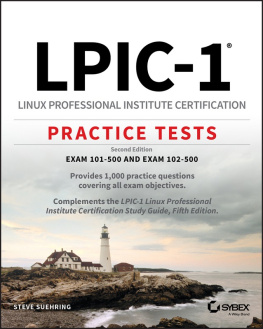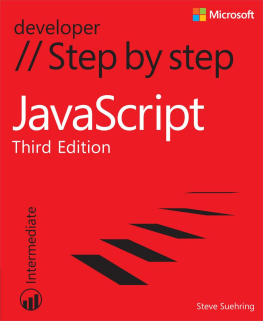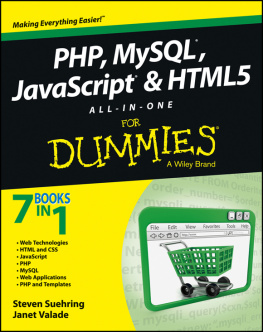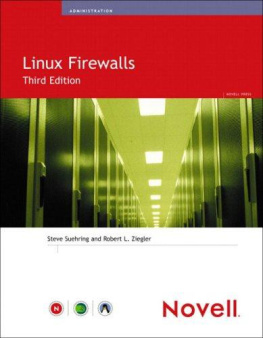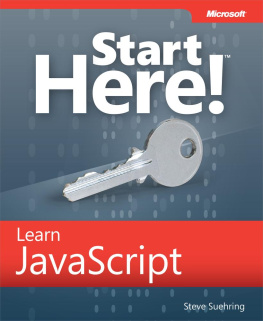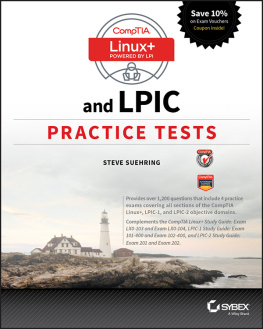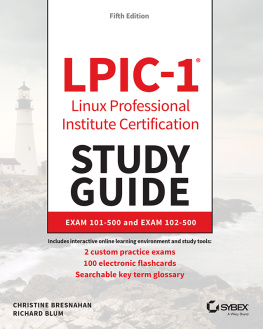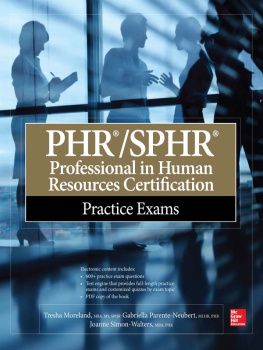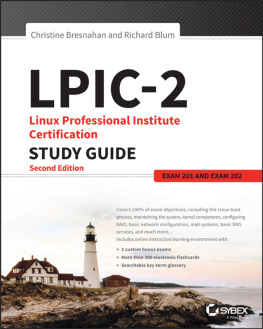
LPIC-1
Linux Professional Institute Certification
Practice Tests
Second Edition

Steven Suehring
Copyright 2020 by John Wiley & Sons, Inc.., Indianapolis, Indiana
Published simultaneously in Canada
ISBN: 978-1-119-61109-7
ISBN: 978-1-119-61114-1 (ebk.)
ISBN: 978-1-119-61113-4 (ebk.)
Manufactured in the United States of America
No part of this publication may be reproduced, stored in a retrieval system or transmitted in any form or by any means, electronic, mechanical, photocopying, recording, scanning or otherwise, except as permitted under Sections 107 or 108 of the 1976 United States Copyright Act, without either the prior written permission of the Publisher, or authorization through payment of the appropriate per-copy fee to the Copyright Clearance Center, 222 Rosewood Drive, Danvers, MA 01923, (978) 750-8400, fax (978) 646-8600. Requests to the Publisher for permission should be addressed to the Permissions Department, John Wiley & Sons, Inc., 111 River Street, Hoboken, NJ 07030, (201) 748-6011, fax (201) 748-6008, or online at http://www.wiley.com/go/permissions.
Limit of Liability/Disclaimer of Warranty: The publisher and the author make no representations or warranties with respect to the accuracy or completeness of the contents of this work and specifically disclaim all warranties, including without limitation warranties of fitness for a particular purpose. No warranty may be created or extended by sales or promotional materials. The advice and strategies contained herein may not be suitable for every situation. This work is sold with the understanding that the publisher is not engaged in rendering legal, accounting, or other professional services. If professional assistance is required, the services of a competent professional person should be sought. Neither the publisher nor the author shall be liable for damages arising herefrom. The fact that an organization or Web site is referred to in this work as a citation and/or a potential source of further information does not mean that the author or the publisher endorses the information the organization or Web site may provide or recommendations it may make. Further, readers should be aware that Internet Web sites listed in this work may have changed or disappeared between when this work was written and when it is read.
For general information on our other products and services or to obtain technical support, please contact our Customer Care Department within the U.S. at (877) 762-2974, outside the U.S. at (317) 572-3993 or fax (317) 572-4002.
Wiley publishes in a variety of print and electronic formats and by print-on-demand. Some material included with standard print versions of this book may not be included in e-books or in print-on-demand. If this book refers to media such as a CD or DVD that is not included in the version you purchased, you may download this material at http://booksupport.wiley.com. For more information about Wiley products, visit www.wiley.com.
Library of Congress Control Number: 2019949012
TRADEMARKS: Wiley, the Wiley logo, and the Sybex logo are trademarks or registered trademarks of John Wiley & Sons, Inc. and/or its affiliates, in the United States and other countries, and may not be used without written permission. ITIL is a registered trademark of Axelos Limited. All other trademarks are the property of their respective owners. John Wiley & Sons, Inc. is not associated with any product or vendor mentioned in this book.
Acknowledgments
Book writing tends to take attention away from other things in life. As I write this and look at the overgrown jungle that is my backyard, it's time to reflect and to find another project so I don't have to deal with whatever type of vine has taken over my shed and is creeping towards the house.
Thank you first to Kenyon Brown and Carole Jelen for this (and other) projects. Thank you also to the editors for this book, Kezia Endsley and David Clinton. Their expertise and diligence is essential in order to make the book the best it can be. Thank you to my family for their continued support. My colleagues at University of Wisconsin- Stevens Point help provide guidance and comic relief at times too.
As is the case for many books now, thank you to Jim, Patti, Tim, and Rob at Partners Pub. Thank you also to Kent Laabs for his generosity and continued help.
About the Author
Steve Suehring is an assistant professor of computing and new media technologies at University of WisconsinStevens Point. Prior to joining the faculty in 2015, Steve gained 20 years of field experience in a variety of technical engineering, system and network administration, and system architectural roles. Steve has written several books and has served as an editor for LinuxWorld magazine.
Introduction
This book provides practice questions for the Linux Professional Institute LPIC-1 certification. Specifically, the book has been updated to reflect the objectives for exams 101-500 and 102-500. The book includes numerous multiple-choice questions related to the exam objectives found on the LPI website.
What Does This Book Cover?
Each chapter of the book connects directly to one of the objectives, and each objective is covered throughout the book. In addition, two practice exams are included in the book that you should find helpful in preparing for the exams.
The book does not require that you start at the beginning and read through in a linear, page-by-page manner. Rather, you may skip to objective areas that might be less familiar, and you can do so without losing any fidelity or missing something from a previous chapter.
Who Should Read This Book
It is assumed that you would have a companion text for this book in order to obtain deeper information on the given subjects for the exam. However, it is possible to use this book as a stand-alone means for preparation.
Here are some basic assumptions about the audience for this book:
- You have used Linux or are using the book to learn Linux.
- You have used a computer for basic operations.
- You will use the book as a means for practicing for the certification exams.
How to Use This Book
This book is best used as a tool for testing your knowledge in the objective domains specified for the exam. The book provides explanations for each question, including, where applicable, explanations as to why the other options were incorrect. Ideally, the book is used in conjunction with the companion text in order to fully explain the concepts.
Certification Exam Policies
The Linux Professional Institute outlines various policies related to certification and other similar matters. In addition, other policies applicable may be through the testing facility or organization. More information on some of the LPI policies can be found at www.lpi.org/policies.
Exam Objectives
The following lists contain the topics and weights for Exams 101 and 102. This list follows the sequence in which they are covered in the book. You can find more information about what is covered in each topic, including key knowledge areas and files, terms, and utilities, at the start of the applicable chapter.
Next page
